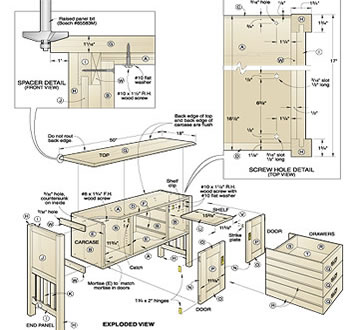Best selling wood projects - Getting started on a break fronted Art Deco style bookcase

Best selling wood projects
A customer has being doing a big renovation to her house, which dates from the end of the Art-Deco era. Tragically, too often these days the timbers removed from these older houses are disposed of, going into landfill - a terrible waste. This is Western Australia, so the timber in these older houses is almost all jarrah (Eucalytpus marginata). Fortunately, my customer Norelle had the sense and foresight to tell the builder she wanted to keep the timbers, in order to use them for other projects around the home. I count it a privilege to have been entrusted with the job of using these timbers to create a big break-fronted Art-Deco style book case for the new living room in the old house. Nice.
Planning the job.
Having met with Norelle, and checked out the huge pile of timber under plastic in her front yard, we discussed ideas for the design and other important matters, like the dimensions and how to make the piece of furniture fit in with the rest of the house. I went home, did some research and drawing work, and a few days later presented the drawing to Norelle. She was pleased with the drawings, and gave me the go-ahead to proceed when ready. A couple of months later, I was ready to get started.
?
??
 |
| The concept plan with suggested measurements. |
I began by doing the sorting, docking, and de-nailing of the timbers in the front yard of Norelles house, as I ratted through the timber pile.
 |
| The larger of the two piles of timber. My resource to work from... |
 |
| Some of the nails and other metalwork removed from the timbers. |
The 8" x 2"s and 9" x1 1/2"s are far too wide for me to flatten over my beautiful old Woodfast 6 inch buzzer. While I have a 15 inch Thicknesser, the creation of the first flat side on these wider sticks has to be done by hand in the absence of a big buzzer. My trusty Stanley No.5 1/2 jack plane and I were working hard on the long 3.0m sticks, with the aid of a pair of winding sticks - but it worked a treat. Mind you, some of the more badly distorted sticks felt the bite of my old electric plane when I had to remove a serious amount of waste! The 9" x 1 1/2" sticks were so badly distorted, I would be unable to get a flat 3.0m length at 25mm thick, the required thickness pre-glue-up. So I had previously docked these into 1.2m lengths, ready to make into shelving. They were still really wild sticks! So to flatten them I made a cradle to which I attached by screws the ends of the short wild sticks, such that the twists and bows were suspended on the average. Creating a sort of lowest common denominator. The whole cradle was then passed through the thicknesser until a flat face was created. After being unscrewed from the cradle, each stick was then put through the thicknesser to the required 25mm. Most of these sticks made it, too. Their previous wild behaviour revealed the most beautiful figure and grain patterns in these nice boards. The cradle method was good for the wide 1.2m sticks, but would be no good for the 3.0m sticks. These would require lots of grunt with the jack plane and or the electric plane in order to establish that first flat face. Thankyou winding sticks! One thing about old painted timbers - its hell on the machines knives. After I had put all the big sticks through the thicknesser, its knives were pretty shot! Time to sharpen those and the buzzer knives again.
Making the vertical ends panels.
Firstly the timber for each of the four end panels was selected, and the edges prepared ready for jointing. The front edge piece on each panel is a heavier section than the panel behind it, as these front edges are to have a nice art-deco type rounded profile shawed from them. All the edge butt joints were to be strengthened by the use of a 1/4" x 1" plywood tongue, with the grooves cut by a slot cutter bit in the router. They were then glued up using a heap of sash cramps and with the wonderful Titebond 3 glue.
| One of the narrower end panels cramped up. |
| Some of the end panel off-cuts, showing the curved built-up front edges and the tongues. |
Making the shelving.
Meanwhile, the timber for the shelf panels were being made. The timber was selected with the aim being to match the colour, grain and figure as much as possible. Using the same tongue and groove method using those beautiful 1/4" ply tongues, the shelves were glued up.
?
| Selecting the timber for similar colour, grain and figure. |
| Three of the glued up shelves. Awesome timber, eh? Such nice wood! |
Keep an eye out for further posts as this project unfolds...?
Best selling wood projects
Best selling wood projects - Getting started on a break fronted Art
Deco style bookcase
 Reviewed by teres
on
14.29
Rating:
Reviewed by teres
on
14.29
Rating:
 Reviewed by teres
on
14.29
Rating:
Reviewed by teres
on
14.29
Rating:
Tidak ada komentar: